
Photo illustration: Snapcode vs AR code
Snapcodes offer a unique, scannable QR code tailored for Snapchat users, enabling quick friend additions and content access, while AR codes integrate augmented reality experiences across various platforms enhancing user engagement. Discover detailed comparisons and use-cases of Snapcode versus AR code in this article.
Table of Comparison
| Feature | Snapcode | AR Code |
|---|---|---|
| Purpose | Quickly add friends or unlock Snapchat content | Trigger AR experiences and interactive filters |
| Technology | Unique QR-style code linked to user profiles or content | AR markers that activate augmented reality effects |
| Design | Yellow ghost icon with dots pattern | Custom visual patterns designed for AR activation |
| Interaction | Scanned via Snapchat camera to add or unlock | Scanned to launch immersive AR content |
| Usage | Profile sharing, unlocking lenses, promotions | Marketing campaigns, interactive storytelling, games |
| Scannability | High reliability under varying conditions | Depends on environment and AR code design |
Introduction to Snapcode and AR Code
Snapcode is a unique QR code used within Snapchat to quickly add friends or unlock exclusive content by scanning with your camera. AR Code integrates augmented reality technology, allowing users to experience interactive filters, lenses, and immersive digital effects directly through Snapcode scans. Your engagement with these codes amplifies social media interaction by blending real-world environments with dynamic AR features.
What is Snapcode?
Snapcode is a unique, scannable QR code used within the Snapchat app to quickly add friends, unlock filters, and access exclusive content. Each Snapcode is visually distinct, featuring a ghost logo surrounded by black dots that function as a machine-readable barcode. By scanning a Snapcode with the Snapchat camera, users streamline connections and enhance interactive experiences without typing usernames.
What is an AR Code?
An AR Code, or Augmented Reality Code, is a digital marker that triggers interactive 3D content when scanned with a compatible device, enhancing user engagement through immersive experiences. Your smartphone or tablet uses the AR Code to overlay virtual images or information onto the real world, making it a powerful tool in advertising, education, and gaming. This technology merges physical and digital environments, creating more personalized and dynamic interactions for users.
How Snapcodes Work
Snapcodes function as customized QR codes for Snapchat, enabling users to quickly add friends or access exclusive content by scanning these unique codes with the app's camera. Each Snapcode encodes a distinctive bitmoji or pattern linked to a specific user profile, lens, or website, streamlining the connection process within social media. The integration of Snapcodes enhances user engagement by simplifying interactions and promoting seamless sharing across the Snapchat platform.
How AR Codes Work
AR codes function by embedding digital information within a visual pattern that can be scanned using a smartphone camera or AR device, triggering the overlay of augmented reality content. When the AR code is detected, the software interprets the encoded data to display interactive elements such as 3D models, videos, or animations within the user's real environment. This technology enhances social media experiences by enabling immersive content sharing and engagement through visual triggers linked to specific digital assets.
Key Differences Between Snapcode and AR Code
Snapcode is a unique QR code linked exclusively to Snapchat accounts, enabling users to quickly add friends or unlock Snapchat filters, while AR Code extends beyond Snapchat by integrating augmented reality experiences across various platforms. Your interaction with Snapcode is primarily within Snapchat's ecosystem, focusing on social connections, whereas AR Code leverages advanced AR technology for marketing, gaming, and interactive content in broader digital environments. The distinct purpose and platform exclusivity of Snapcode versus the versatile application of AR Code highlight their key differences in social media engagement and augmented reality usage.
Use Cases for Snapcodes
Snapcodes serve as powerful tools for seamless user engagement on social media platforms, enabling quick access to profiles, websites, and exclusive content. Brands leverage Snapcodes to drive customer interaction through promotions, event invitations, and personalized AR experiences that deepen brand loyalty. These scannable codes enhance marketing campaigns by simplifying user connectivity and boosting sharing capabilities across Snapchat and associated social networks.
Use Cases for AR Codes
AR codes transform social media marketing by enabling interactive experiences such as virtual try-ons for fashion and beauty products, enhancing user engagement and boosting conversion rates. Brands leverage AR codes to provide immersive storytelling, allowing Your audience to scan codes and instantly access exclusive content or product information. These use cases increase brand visibility and create personalized customer interactions, driving higher retention and loyalty on social media platforms.
Pros and Cons: Snapcode vs AR Code
Snapcode offers seamless user engagement through instant access to Snapchat profiles and filters, enhancing personalized social media interaction. AR Code integrates augmented reality experiences, providing immersive content that boosts user retention and brand interaction on platforms supporting AR technology. However, Snapcode is limited to Snapchat users, reducing cross-platform applicability, while AR Code requires compatible devices and may face adoption barriers due to technical complexity and higher development costs.
Future Trends in Snapcode and AR Code Technology
Snapcode and AR Code Technology are poised to revolutionize user engagement on social media by enhancing interactive experiences through augmented reality. Future trends include seamless integration of AR codes into everyday social applications, enabling real-time, personalized content delivery and immersive brand interactions that boost user retention. Your social media strategy can leverage these advancements to create innovative marketing campaigns and elevate user participation.
 socmedb.com
socmedb.com